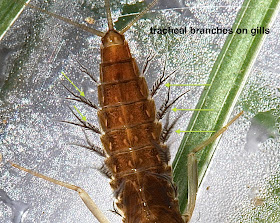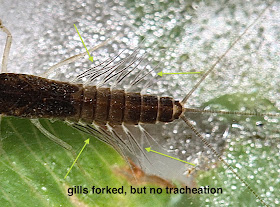Thursday, July 25, 2013
Stumped by a pronggilled mayfly at the Rapidan River
As I was collecting insects this morning at the Rapidan River, I was very excited to see this little (5mm) nymph. It's a pronggilled mayfly, and as I was taking my photos I was quite sure it was another Habrophlebia vibrans, a species I've seen only one time before -- two years ago at the Rapidan River in spring. This is Habrophlebia vibrans.
When I got home and downloaded my photos, I quickly saw that I was mistaken. Note how the gills are in "clusters" on the H. vibrans nymph, not so on the nymph that I found this morning. The gills on that nymph are "forked, bilamellate," which is the form that gills take on the genus we most commonly see in our streams -- Paraleptophlebia. However, the Paraleptophlebias that I normally see look like this.
Not only does the color and pattern differ significantly from this morning's nymph, note the difference in gills. Those on the nymph in this photo, fork at the middle of the gill, and in the portion in front of the fork, there are well defined tracheal branches. These.
The gills on the nymph that I found this morning are forked from the base of the gills, and they lack tracheation.
More photos:
I'm not sure what I found. At the moment, I think this nymph is also Paraleptophlebia, it's just a different species than the Paraleptophlebias that I normally see. Beaty notes that North Carolina has at least 8 species of Paraleptophlebia, but he tells us to leave ID at the level of genus ("The Ephemeroptera of North Carolina," p. 40). Still, apparently there is a key one can use to narrow this down, so I plan to look into this further.
(By the way, I have seen photos of Paraleptophlebias with gills that lack tracheation like the one that I found this morning. See, for example, the photo of Paralpetophlebia bicornuta at http://bugguide.net/node/view/796600.)
_______________
Other discoveries this morning.
1) A beautiful flatheaded mayfly, Epeorus vitreus. There seemed to very few of them around. (Note how transparent the leading edge of the head has become.)
2. I saw a lot of the "summer batch" of Brachycentrids (humpless casemakers), Brachycentrus appalachia.
3. Small minnow mayfly, Baetis intercalaris. (Also saw Acentrella turbida nymphs.)
4. A quite mature Perlodid stonefly, Isoperla holochlora. These are long gone from most of the streams that I visit, but the Rapidan is up in the mountains where things take longer to mature.
5. And then there was this wonderful butterfly which stopped by to see what on earth I was doing!
Feel free to help me out with identification.














The visitor was a Silver-spotted Skipper (Epargyreus clarus)!
ReplyDeleteTerrific! Thanks so much for the identification.
DeleteBob